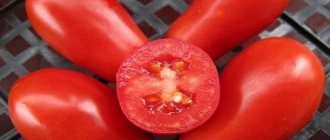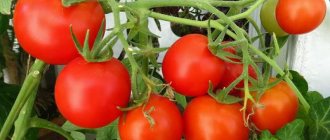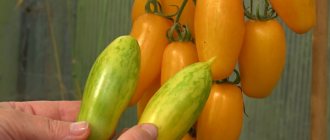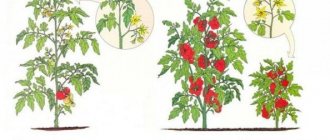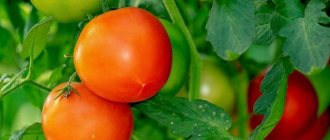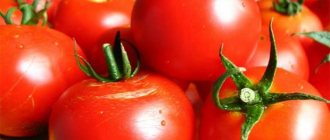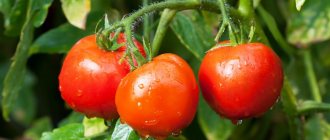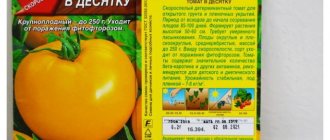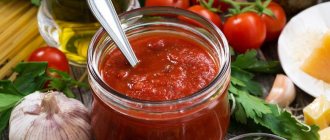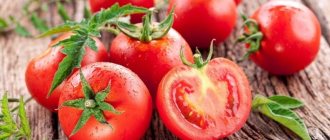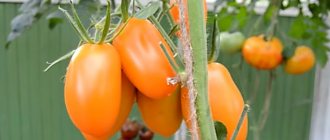Greenhouse requirements
How to grow tomatoes in a greenhouse all year round? To grow vegetables, and tomatoes in particular, you will need a warm and bright greenhouse . It must be made of thick glass or polycarbonate with a thickness of at least 4.5–5 mm. It is not recommended to make greenhouses that are too high; in such greenhouses the heat will go up and accumulate in the ceiling area.
insulation should be installed around the entire perimeter to protect plants during periods of severe, prolonged cold. Frame lintels must be positioned longitudinally at a distance of 75–90 cm from each other. This design will help avoid damage to the walls during heavy snowfalls.
A greenhouse for growing tomatoes all year round should not just sit on the ground! It is recommended to install it on a wooden platform made of thick beams. In addition, it is necessary to make a concrete base, on top of which lay polystyrene foam. Otherwise, the plants may freeze when the soil cools too much.
The greenhouse must be equipped with good lighting and heating. For illumination, sodium and fluorescent lamps are usually used . Read how to place a greenhouse on your site on our website.
In the fall, the room needs to be prepared:
- Clean the greenhouse from dirt and debris.
- Check all electrical appliances, plumbing system, troubleshoot and return to working order.
- Disinfect all with a solution of potassium permanganate. You can fumigate the room with sulfur bombs.
Sales markets, sales of tomatoes
You should find ways to sell vegetables even before harvesting. Large batches of tomatoes can be sold in the following ways:
- sell in bulk to large supermarkets and stores: this is one of the simplest methods of sales, but not very profitable, since you have to sell vegetables at reduced wholesale prices;
- opening your own point at the vegetable market: in this case, you can sell vegetables at retail prices, which will increase profits;
- sales of products to processing plants, where juices, pastes, and canned food are prepared from tomatoes.
You can also spread the word about selling tomatoes online. Many people who live in urban areas want to eat fresh tomatoes and prepare them for the winter. You can offer a lower price for these vegetables.
A tomato growing business is a way to make a profit all year round. This type of activity has its own advantages and disadvantages. To grow tomatoes, you need to have an understanding of agricultural activities.
Suitable varieties
When choosing varieties, you should give preference to those that meet certain requirements:
- indeterminateness . The bushes can be allowed to grow upward, making maximum use of the area of the room;
- high productivity;
- early and very early periods of fruit ripening;
- excellent taste properties;
- high resistance to various diseases and attacks by harmful insects;
- long keeping quality.
These varieties include: tomato tree Sprut, Malyshok, Annabelle, Dobrun, Flamenco, Pink Flamingo, Junior, Samara, Yantarny, Hurricane.
Hurricane is a high-yielding, early-ripening variety. It is universal in use, has excellent taste properties and a high content of vitamin C.
Amber is an ultra-early ripening, productive variety, very resistant to late blight and macrosporosis (see photo below).
Samara is an indeterminate early-ripening hybrid variety. Universal use, high resistance to most diseases (see photo below).
Junior is an ultra-early ripening, super-determinate hybrid. It is distinguished by strong resistance to many diseases and excellent taste of the fruit.
Pink Flamingo is an early ripening, indeterminate variety. Produces very tasty and shelf-stable tomatoes. The shelf life is about 60–70 days (see photo below).
Flamenco is an early ripening, semi-determinate hybrid. The fruits are used universally, the taste properties are excellent, and the yield is high. In addition, the variety is resistant to most diseases.
Dobrun is a hybrid indeterminate variety with high disease resistance and excellent keeping quality.
Octopus is a unique variety of tomatoes that are grown on trees. It has phenomenal productivity (see photo below).
Annabelle is an indeterminate high-yielding hybrid. Very resistant to a whole range of diseases and root-knot nematodes.
Malyshok is an early ripening super-determinate variety intended only for cultivation in a greenhouse. The hybrid is distinguished by its genetic resistance to diseases.
Other tomato varieties recommended for greenhouses, presented on our website: Chocolate, Kishmish, Yellow Pear, Domes of Russia, Pride of Siberia, Pink Impression, Novichok, Wonder of the World, President 2
What affects productivity
Care and painstaking work do not always help a farmer get the desired profit from a vegetable garden. It happens that the same tomato variety bears fruit differently in different owners. This depends on the following factors:
- genetic and geographical characteristics of the variety;
- soil fertility;
- quality of seedlings;
- climate of the area;
- timely watering;
- fertilizers and fertilizing;
- tying;
- pest control.
Before settling on a particular variety of tomatoes, you should consult with gardeners who grow plants in the same area. It is advisable to focus on the numbers indicated on the packages of seeds.
Yield indicators
There are standard indicators for the yield of tomatoes from the garden. Approximate indicators from one bush per season, subject to established recommendations:
- early maturing, low-growing determinate - 1-5 kg;
- tall indeterminate - 5-10 kg or more (in greenhouse conditions);
- large pink tomatoes - 8-16 kg.
Tatyana Orlova (candidate of agricultural sciences):
As a rule, the average yield of a given plant is indicated on the bag of seeds. It may be higher or lower than the stated figures, but still gives an idea of the true yield. The average weight of 1 fruit is also indicated.
High-yielding varieties
There is a large selection of high-yielding varieties
- medium-growing variety Intuition F1, unpretentious and resistant to fungus, brings 10-12 kg per bush;
- multi-colored varieties (Goldfish, Black Prince, Marshmallow) - up to 8 kg;
- Emerald apple - up to 10 kg;
- De Barao yellow - up to 15 kg;
- large-fruited red and pink varieties also delight owners with high performance both indoors and outdoors: Krasnobay is one of the most productive tomatoes, yielding up to 30 kg per bush in a good season, Giants Novikova and De Barao - up to 15 kg , Pink giant - up to 12 kg, early Puzata Khata and Rozana are less prolific - up to 10 kg;
- early variety Vitador F1 - 25 kg per 1 sq. m and Kostroma F1 - 18 kg per 1 sq. m.
Soil preparation
Before planting seedlings, the soil can be replaced with new soil or the old one can be disinfected. For this, solution of potassium permanganate is used . They thoroughly pour over the entire soil.
After the soil dries, it is recommended to dig it up. At the same time, compost is added in an amount of 1.5–2 buckets per square meter of area. It can be replaced by a family of Californian worms. Their activity will improve the porosity of the soil and regularly enrich it with vermicompost.
It is also advisable to improve the soil with mineral fertilizers. For this, the following complex is being prepared:
- copper sulfate (5g);
- potassium magnesia (50g);
- ferrous sulfate (5g);
- potassium chloride (30g);
- double superphosphate (50g).
If you plant tomatoes after cucumbers, you should add sawdust or sphagnum peat to the soil instead of compost.
Treating the soil with fungicides will help prevent pest infestations.
Features of care
How to grow tomatoes in a greenhouse in winter? Young sprouts are moved into the greenhouse only after they reach a height of 18–21 cm. Before this, they are fed several times with a mixture of phosphorus, nitrogen and potassium. In greenhouses, it is most convenient to use the strip planting method.
The distance between the ribbons should be at least 80 cm, between plants about 55–65 cm. It is recommended to tie a rope or wire along the ribbon of planted bushes so that the seedlings grow vertically. As they grow, they form regular bushes , carrying out timely pinching.
Indeterminate varieties are made in one shoot, the rest - in two. The tops of all excess stems are plucked off. It is also recommended to remove all lower foliage.
The optimal soil temperature is about 19ºC, air temperature is 23ºC–26ºC. It is better to water before lunch , moistening the soil as it dries. With a constant lack of moisture, the development of bushes stops, and the ovaries and inflorescences begin to fall off. Loosening of the soil between the tapes and under the bushes is carried out regularly throughout the entire life of the plants.
When growing tomatoes in a greenhouse in winter, it is necessary to fertilize. Without the constant addition of mineral complexes to the soil, plants will stop bearing fruit and fully developing.
to feed the bushes every 13–15 days . To do this, use a mixture of ammonium nitrate (15g), superphosphate (40g) and potassium salt (20g).
Before the formation of inflorescences, a 0.6% concentration of the working solution is used, and then it is increased to 1%. The consumption rate is a bucket of solution per square meter of soil. To ensure normal photosynthesis under artificial conditions, open containers filled with a mixture of mullein and water must be placed in the greenhouse. This will enrich the air with carbon dioxide, necessary for the process of photosynthesis.
When grown in open ground, the inflorescences are pollinated by bees. There are none in the greenhouse, so pollination will have to be done independently . To do this, each tassel with flowers is lightly shaken, and then gently watered from above from a watering can.
Secret 4: strong roots
No one will even argue: the stronger and stronger the root, the more fruits it can provide with nutrition, and the larger these fruits can be. What can we do to “strengthen” the root system of a tomato bush?
Spud
Hilling, it turns out, also has its secrets. It is necessary to hill up at the moment of root growth... but the roots of tomatoes do not grow continuously, but in periods. It happens something like this: at first the roots grow rapidly, then they slow down their growth, and the vegetative mass begins to actively grow. Then root growth is activated again - until the moment when flowering and fruit set begin. Once this process has begun, the roots slow down their growth again.
It is necessary to hill up tomatoes at the moment of root growth
The plants themselves will tell you when it’s time to hill up. Keep an eye on the stem: if small protuberances, like pimples, appear on it near the ground itself, this means you can spud for the first time (be sure to use moist soil, not dry!). And when the stem near the ground changes color from green to bluish, it tells you that the time has come for the second hilling. If you follow this and do everything in a timely manner, the tomato will be able to grow its root system as much as possible, thereby providing more strength for the harvest!
Mulch
No one has doubted the benefits of mulching for a long time. Under the protective layer of mulch, a soil crust does not form, moisture is retained, the soil structure is not disturbed, weeds do not sprout and roots are not exposed when watering. That's the whole secret: one mulch - but many benefits! Summer residents testify: proper mulching can increase the yield of a bush... by 25-30%!
In the following video, Valery Medvedev talks about mulching tomatoes with forest soil:
How can you mulch tomatoes? Hay, straw, compost, sawdust, newsprint, fallen leaves, grass clippings, tree bark, pine needles, peat and even your own leaves. The main thing is to choose the right mulch for your conditions and apply it correctly:
- How people mulch their beds: 14 of the most practical ways that I managed to spy;
- Secrets of mulching with organic materials;
- Mulching beds with cut grass is another recipe for an excellent harvest.
